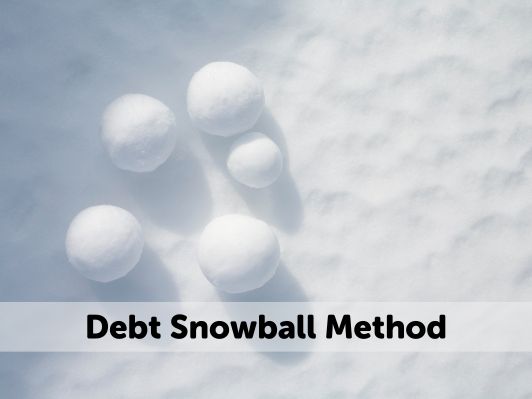Dealing with debt can be overwhelming, especially when multiple credit card balances, loans, and outstanding bills are competing for your attention. The debt snowball method is a popular strategy for managing and paying off debt.
This article will provide a comprehensive overview of this method, breaking down its principles and illustrating how it can be effectively implemented. Whether you’re just starting your journey to financial freedom or looking for new strategies to accelerate your progress, this guide will get you closer to becoming debt-free.
Table of Contents
What is the debt snowball method?

The debt snowball method is a debt reduction strategy where you pay off debts in order of smallest to largest, gaining momentum as each balance is paid off. When the smallest debt is paid in full, you roll the money you were paying on that debt into the next smallest balance.
How to implement the debt snowball method
1. List all your debts
To get started, compile a list of all your outstanding debts. This includes credit card debt, personal loans, car loans, medical bills, and any other financial obligations you may have. Don’t forget to note down the interest rates associated with each debt.
2. Order debts by balance
Once you have your list, arrange your debts from smallest balance to largest balance. This sorting technique sets the stage for the snowball effect to kick in.
3. Make your minimum monthly payments
Continue to make the minimum monthly payment on all your debts. This is crucial to avoid late fees, plus it will improve your credit score.
4. Allocate extra funds
Allocate any extra money you have to the debt with the smallest balance. This could be money from your income, a side job, or any other source. By doing so, you accelerate the repayment process for this first debt and set the snowball rolling.
5. Roll over payments
Once the smallest debt is fully paid off, don’t just pocket the extra money. Instead, roll it over to the next smallest debt, adding it to the minimum payments you were already making on that debt.
6. Repeat
Continue this process, rolling over payments to the next smallest debt as each one is paid off. Over time, your payments will “snowball,” allowing you to pay off larger debts more quickly.
7. Celebrate victories
As you pay off each small debt, celebrate your achievements. These victories serve as powerful motivators. Fueling your determination to pay off debt and eliminate larger debts.
Overcoming challenges and staying motivated

Overcoming challenges and staying motivated with your debt repayment strategy can be tough. But it’s crucial for success. Here are some strategies to maintain your determination:
Set clear goals: Define what you want to achieve at the end of your debt repayment journey. It could be a debt-free life, saving for a house, or building an emergency fund. Having a clear goal can keep you focused and motivated.
Stay informed: Educate yourself about personal finance and debt management. The more you know, the better decisions you’ll make. This knowledge can also empower you to stay on track.
Build a support system: Share your debt repayment goals with friends or family. They can provide emotional support, hold you accountable, and celebrate your victories with you.
Maintain a positive attitude: Debt repayment can be a long journey, and it’s easy to get discouraged. Try to stay positive and visualise the benefits of a debt-free life.
Factors to consider when choosing the right debt management strategy
Total debt amount: Start by assessing the total amount of debt you owe. This includes credit card debt, loans, mortgages, and any other outstanding balances. Knowing the magnitude of your debt will help you determine the best approach.
Interest rates: Take note of the interest rates on your debts. High-interest debts, like credit cards, should be prioritised for repayment due to the substantial cost over time.
Debt types: Different types of debt may have different implications. A car loan, mortgage and student loan may offer tax benefits. Plus, have more lenient repayment terms compared to credit card debt.
Credit score: Your credit score can impact the interest rates you receive on loans and credit cards. Be mindful of how debt management strategies may affect your creditworthiness.
Risk tolerance: Assess your tolerance for financial risk. Some strategies, like debt consolidation or refinancing, may involve risks or changes to your financial structure.
Lifestyle changes: Consider any major lifestyle changes or expenses on the horizon. This could be starting a family, buying a home, or going back to school. These may affect your debt management choices.
Long-term financial plan: Consider how your debt management strategy fits into your long-term financial plan. This includes retirement savings, investments, and other financial goals.
Consistency: Whatever strategy you choose, consistency in making payments is essential. Timely payments can positively impact your credit score and overall financial health.
Review periodically: Finally, periodically review your strategy. As your financial situation evolves, adjustments may be necessary to ensure you’re on the right path.
Alternatives to the debt snowball method
While the debt snowball method is a popular and effective strategy for paying off debt, there are several alternatives to consider, each with its own advantages and disadvantages. Here are some alternatives:
1. Debt avalanche method
In contrast to the debt snowball, the debt avalanche focuses on paying off debts with the highest interest rates first.
This method saves you more money in interest payments over time but may take longer to see individual debts completely paid off.
It’s a great choice if you’re primarily concerned with minimising interest costs.
2. Debt consolidation
Debt consolidation involves taking out a single loan or using a balance transfer credit card to combine multiple debts into one.
This can simplify your payments and potentially reduce interest rates.
However, be cautious about the terms of the consolidation loan or credit card to ensure it’s a financially beneficial move.
3. Snowflake method
This approach complements other debt repayment strategies by finding and applying small, extra payments whenever possible.
Whenever you have some extra money, like a bonus at work or a tax refund, you apply it immediately to your debt.
This method accelerates debt payoff without relying solely on a structured plan.
Bottom line
The debt snowball method offers a practical and motivational approach to conquering your financial burdens. By tackling smaller debts, you are empowered to regain control of your finances.
FAQs
What are the 3 biggest strategies for paying down debt?
The debt snowball method focuses on paying off the smallest debts. The debt avalanche focuses on high-interest debts. And debt consolidation combines debt into one for simplicity.
How do I legally write off debt UK?
Options include Individual Voluntary Arrangements (IVAs), Debt Relief Orders (DROs), and bankruptcy.
What is the debt snowflake method?
This method involves making small, frequent payments toward debts whenever you can spare money. It complements the debt snowball or avalanche method by using micro-payments to chip away at debt. This minimises the impact and accelerates the repayment process.
Does the debt snowball really work?
Yes, the debt snowball method can be effective for some people. By focusing on the smallest debts first, people can experience quick wins. This can boost motivation and the feeling of progress.
Disclaimer: The information given above is provided for reference only. This is not financial advice.
Related guides:
Best Ways to Save Money This Winter

